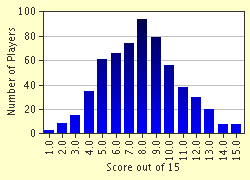Quiz Answer Key and Fun Facts
1. In 1923, a massive earthquake struck Tokyo, killing 99,000 people. The quake, however, was not directly responsible for most of the deaths. What was?
2. What was the name of the city which was completely destroyed by Mont Pelee in Martinique when it erupted on May 8, 1902?
3. The explosion of which of the following volcanoes in 1669 caused a local war?
4. Where did the worst quake disaster in terms of death and destruction ever recorded take place?
5. Tsunamis can crest at more than how many feet?
6. Where did the largest known tsunami take place?
7. In what year did the island of Krakatoa explode?
8. An earthquake whose epicenter was 100 miles away from Anchorage, Alaska buckled and cracked the sidewalks of that city in 1964, and made the land rise and fall visibly over an area estimated at 80,000 square miles. The resulting tsunamis destroyed sections of Valdez, Alaska and Crescent City, California as well. On which of the following holidays did the earthquake occur?
9. What was the name of the volcano which erupted in 1783 in Iceland, killing 1 in 5 of the island's inhabitants and opening up a fissure 18 miles long?
10. Who witnessed and wrote about the eruption of Vesuvius and the resulting destruction of Pompeii and Herculaneum?
11. Which of the following events coincided with one of New Zealand's worst natural disasters, a huge mudflow composed of some 600 million gallons of hot acidic water and debris which burst from the crater lake of Ruapehu, in 1953?
12. Which of these caused the highest number of deaths?
13. In 1951 a commercial airliner was almost brought down by ash from an erupting volcano.
14. Who was the first person to name hurricanes?
15. A hurricane releases as much energy as four hundred 20-megaton H-bombs every minute.
Source: Author
lsvitko
This quiz was reviewed by FunTrivia editor
bloomsby before going online.
Any errors found in FunTrivia content are routinely corrected through our feedback system.

